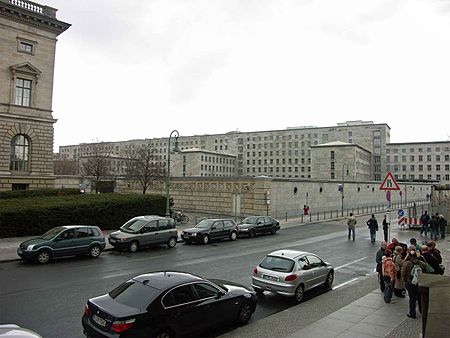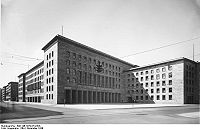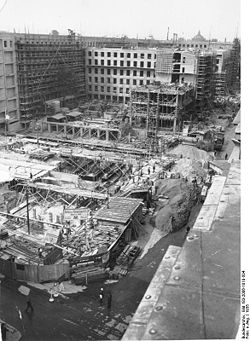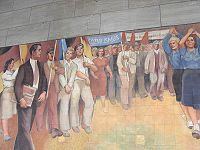- Detlev-Rohwedder-Haus
-
The Detlev-Rohwedder-Haus (Detlev Rohwedder House) is a building in Berlin that at the time of its construction was the largest office building in Europe. It was constructed between February 1935 and August 1936 to house the Ministry of Aviation.
During the German Democratic Republic (East Germany) it was known as the Haus der Ministerien ("House of Ministries"). In 1992 it was named the Detlev Rohwedder Building, in honour of Detlev Karsten Rohwedder, the assassinated head of the Treuhand, which had its headquarters there 1991-95. Still, the building is more commonly known as the Air Ministry Building. Since 1999, the building is the seat of the German Finance Ministry.
Contents
Design and construction
The building was designed by Ernst Sagebiel (1892–1970), who shortly afterwards rebuilt Tempelhof Airport on a similarly gigantic scale. One writer has described it as "in the typical style of National Socialist intimidation architecture."[1] It ran for more than 250 m along Wilhelmstraße, partly on the site of the former Prussian War Ministry dating from 1819, and covered the full length of the block between Prinz-Albrecht-Straße and Leipziger Straße, even running along Leipziger Straße itself to join on to the Prussian House of Lords, today housing the Bundesrat. It comprised a reinforced concrete skeleton with an exterior facing of limestone and travertine (a form of marble). With its seven storeys and total floor area of 112,000 sq m, 2,800 rooms, 7 km (4 mi) of corridors, over 4,000 windows, 17 stairways, and with the stone coming from no fewer than 50 quarries, the vast building served the growing bureaucracy of the Luftwaffe, plus Germany's civil aviation authority which was also located there. Yet it took only 18 months to build, the army of labourers working double shifts and Sundays. The first 1,000 rooms were handed over in October 1935 after just eight months' construction. When finally completed, 4,000 bureaucrats and their secretaries were employed within its walls.
Post-WWII
The Air Ministry building was one of the few major public buildings in central Berlin to escape serious damage during the Allied bombing offensive in 1944-45. Afterwards the huge structure was quickly repaired, only the Ehrensaal (Hall of Honour) being much altered, remodelled into the Stalinist neo-classicist Festsaal (Festival Hall), and the enormous Eagle and Swastika that adorned its end wall being removed.
Once the work was complete, the building was used by the Soviet military administration until 1948, and from 1947-49 by the German Economic Commission (Deutsche Wirtschaftskommission or DWK), which became the top administrative body in the Soviet Occupation Zone. In this time it became officially known as Haus der DWK ("House of the 'DWK'"). On 7 October 1949 the German Democratic Republic (GDR) was founded in a ceremony in the Festsaal, with Wilhelm Pieck as President and Otto Grotewohl as Minister-President (Ministerpräsident). Later the building served the Council of Ministers of the GDR and other affiliated organizations of the GDR, hence its new name Haus der Ministerien (House of the Ministries).
In 1950-52 an extraordinary 18 meter long mural was created at the north end along Leipziger Straße, set back behind pillars, made out of Meissen porcelain tiles. Created by the German painter and commercial artist Max Lingner together with 14 artisans, it depicts the Socialist ideal of contented East Germans facing a bright future as one big happy family. In fact the mural's creation had been a somewhat messy affair. Commissioned by Prime Minister Otto Grotewohl, Lingner had had to revise it no fewer than five times, so that it ultimately bore little resemblance to the first draft. Originally based on family scenes, the final version had a more sinister look about it, a series of jovial set-pieces with an almost military undertone, people in marching poise and with fixed, uniform smiles on their faces. Lingner hated it (as well as Grotewohl's interference) and refused to look at it when going past. With a degree of irony, the building became the focal point a year later of the Uprising of 1953 in East Germany.
After reunification
From 1991–95, after German reunification, it housed the Treuhand (Trust Establishment), which privatized former enterprises operated by the deposed communist regime of East Germany. Its first chairman was Detlev Rohwedder, who was murdered by RAF terrorists on 1 April 1991, after which the building was renamed the Detlev Rohwedder House (German: Detlev-Rohwedder-Haus) on 16 January 1992 in his honour. From 1990 the Berlin branch office of the German Finance Ministry was also located here, and since 1999, following a vast refurbishment, the building has served as the Ministry's headquarters.
At the north (Leipziger Straße) end of the building, a plaque commemorates the protest meeting of 16 June 1953, from which stemmed the following day's Uprising of 1953 in East Germany. Since 1993 the nearby 1950s Lingner mural has been joined by another scene set into the ground nearby: a huge blown-up photograph of 1953 protesters shortly before their gathering was suppressed.
References
External links
Coordinates: 52°30′31.31″N 13°23′2.4″E / 52.5086972°N 13.384°E
Categories:- Nazi architecture
- History of Berlin
- Buildings and structures in Berlin
- Buildings and structures completed in 1936
Wikimedia Foundation. 2010.




